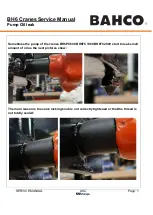
BRIDGE DECK FINISHER SET-UP GUIDE - 069596
Page 13
Paving Operation
SUPER ELEVATIONS
• For super elevated bridge decks, skewed decks
or slabs, the roller rotation must be turning in the
same direction with the valve lever set in the “Non-
Reversing” position.
• Paving carriage travel from the low side to the high
side of the elevation pushes the concrete to the top
and screed the material to grad (
ONLY PAVING TO THE
HIGH SIDE
)
• The paving carriage rolls over the surface going down
the super elevation and does not screed the surface to
grade.
• Roller direction will depend on the direction of the pour
and which is the high side. (SEE PICTURE)
PAVING UP & DOWN GRADES
• The rear of the paving rollers may need to be raised
higher (approximately 1/8” to 1/4”) when paving up a
grade or slope.
• Turn the leg crank 1/2 turn counter clockwise to raise
the back of the machine 1/8 of an inch.
• With the back of the machine raised, the augers
may need to be adjusted lower, watch the amount
of concrete the rollers are carrying. (Use the hand
crank on the sides of the carriage to adjust the auger
elevation) These adjustments will counteract the
tendency of excess concrete from moving downhill
toward the paving rollers.
• The concrete may tend to “run-away” form the
machine when paving down a grade and the augers
may need to be raised higher to provide the proper
amount of concrete to the paving rollers.
• The rear of the paving rollers may not need to be raised
but make sure there is as much total contact with the
deck or slab surface, because when paving downhill,
you want maximum surface contact with the concrete
but careful not to allow any ridge, excess concrete or
lines to come off the rear of the paving rollers.








































